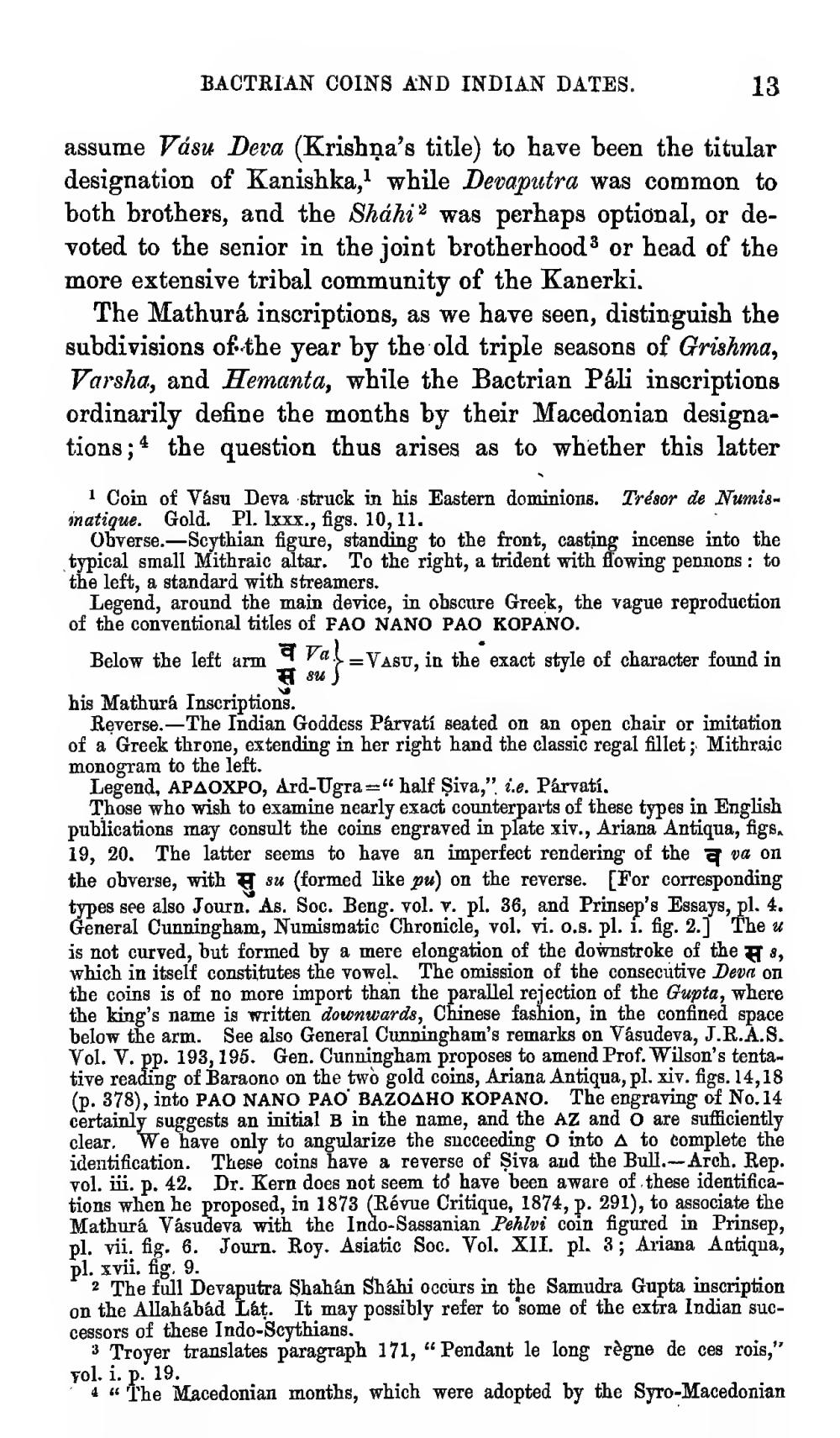________________
BACTRIAN COINS AND INDIAN DATES.
13
assume Vásu Dera (Krishṇa's title) to have been the titular designation of Kanishka,1 while Devaputra was common to both brothers, and the Shahi? was perhaps optional, or devoted to the senior in the joint brotherhood 3 or head of the more extensive tribal community of the Kanerki.
The Mathura inscriptions, as we have seen, distinguish the subdivisions of the year by the old triple seasons of Grishma, Varsha, and Hemanta, while the Bactrian Pali inscriptions ordinarily define the months by their Macedonian designations; 4 the question thus arises as to whether this latter
1 Coin of Vásu Deva struck in his Eastern dominions. Trésor de Numisinatique. Gold. Pl. lxxx., figs. 10,11,
Obverse.—Scythian figure, standing to the front, casting incense into the typical small Mithraic altar. To the right, a trident with flowing pennons : to the left, a standard with streamers.
Legend, around the main device, in obscure Greek, the vague reproduction of the conventional titles of FAO NANO PAO KOPANO.
Below the left arma Va. =Vasu, in the exact style of character found in
su
his Mathurá Inscriptions. Reverse. The Indian Goddess Parvatí seated on an open chair or imitation
and the classic regal fillet; Mithraic monogram to the left.
Legend, APAOXPO, Ard-Ugra="half Şiva,". i.e. Parvatí,
Those who wish to examine nearly exact counterparts of these types in English publications may consult the coins engraved in plate xiv., Ariana Antiqua, figs. 19, 20. The latter seems to have an imperfect rendering of the a va on the obverse, with su (formed like pu) on the reverse. (For corresponding types see also Journ. As. Soc. Beng. vol. v. pl. 36, and Prinsep's Essays, pl. 4. General Cunningham, Numismatic Chronicle, vol. vi. o.s. pl. i. fig. 2.) The u is not curved, but formed by a mere elongation of the downstroke of the As, which in itself constitutes the vowel. The omission of the consecutive Deva on the coins is of no more import than the parallel rejection of the Gupta, where the king's name is written downwards, Chinese fashion, in the confined space below the arm. See also General Cunningham's remarks on Vasudeva, J.R.A.S. Vol. V. pp. 193, 195. Gen. Cunningham proposes to amend Prof. Wilson's tentative reading of Baraono on the two gold coins, Ariana Antiqua, pl. xiv. figs. 14,18 (p. 378), into PAO NANO PAO BAZOAHO KOPANO. The engraving of No.14 certainly suggests an initial B in the name, and the AZ and o are sufficiently clear. We have only to angularize the succeeding o into A to complete the identification. These coins have a reverse of Şiva and the Bull.-- Arch. Rep. vol. üü. p. 42. Dr. Kern does not seem to have been aware of these identifications when he proposed, in 1873 (Révue Critique, 1874, p. 291), to associate the Mathurá Vásudeva with the Indo-Sassanian Pehlvi coin figured in Prinsep, pl. vii, fig. 6. Journ. Roy. Asiatic Soc. Vol. XII. pl. 3; Ariana Antiqua, pl. xvii. fig. 9.
2 The full Devaputra Shahan Sháhi occurs in the Samudra Gupta inscription on the Allahabad Laţ. It may possibly refer to some of the extra Indian successors of these Indo-Scythians.
3 Troyer translates paragraph 171, “Pendant le long règne de ces rois," yol. i. p. 19.
4 " The Macedonian months, which were adopted by the Syro-Macedonian




